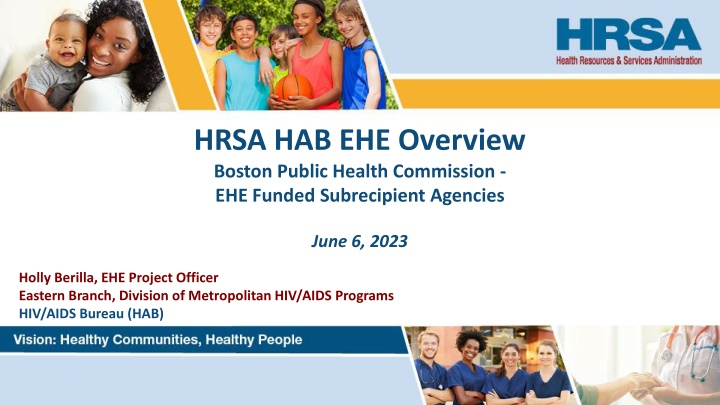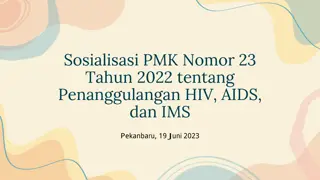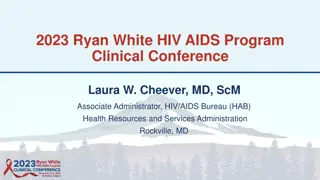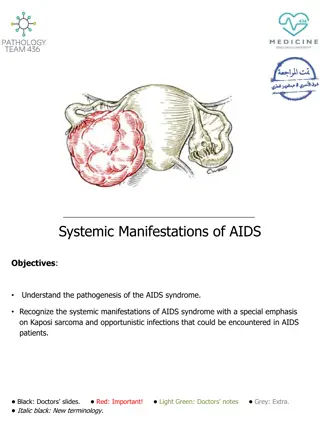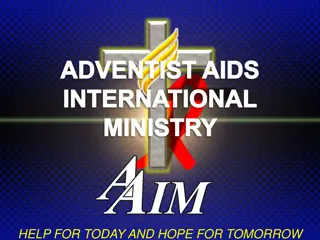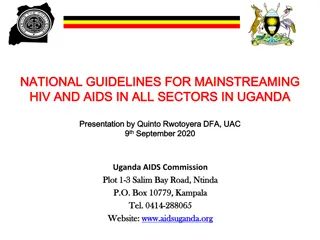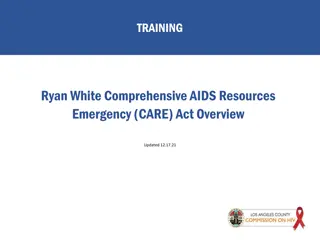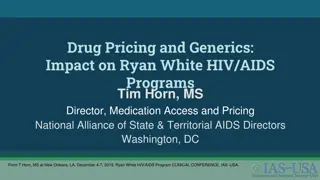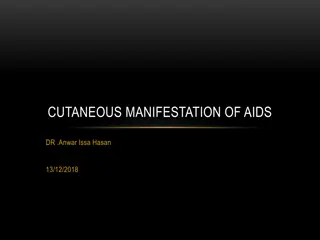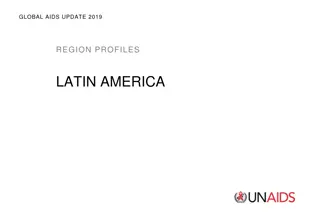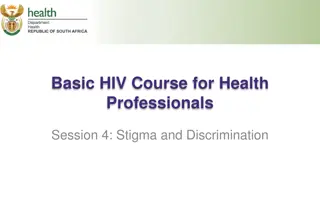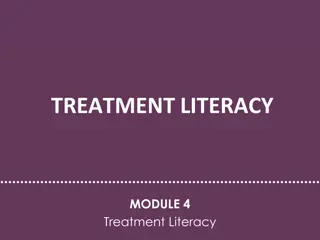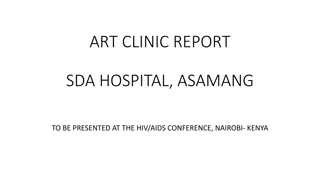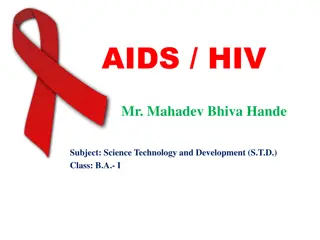Overview of HRSA HIV/AIDS Bureau EHE Initiative
The HRSA HIV/AIDS Bureau's Ending the HIV Epidemic (EHE) initiative aims to reduce new HIV infections to less than 3,000 per year by 2030 by focusing on diagnosis, treatment, prevention, and rapid response to outbreaks. This presentation provides insights into the EHE cooperative agreement, allowable expenses, data reporting, and resources available to combat HIV/AIDS effectively.
Download Presentation

Please find below an Image/Link to download the presentation.
The content on the website is provided AS IS for your information and personal use only. It may not be sold, licensed, or shared on other websites without obtaining consent from the author.If you encounter any issues during the download, it is possible that the publisher has removed the file from their server.
You are allowed to download the files provided on this website for personal or commercial use, subject to the condition that they are used lawfully. All files are the property of their respective owners.
The content on the website is provided AS IS for your information and personal use only. It may not be sold, licensed, or shared on other websites without obtaining consent from the author.
E N D
Presentation Transcript
HRSA HAB EHE Overview Boston Public Health Commission - EHE Funded Subrecipient Agencies June 6, 2023 Holly Berilla, EHE Project Officer Eastern Branch, Division of Metropolitan HIV/AIDS Programs HIV/AIDS Bureau (HAB)
HIV/AIDS Bureau Vision and Mission Vision Optimal HIV care and treatment for all to end the HIV epidemic in the U.S. Mission Provide leadership and resources to advance HIV care and treatment to improve health outcomes and reduce health disparities for people with HIV and affected communities. 2
Overview of Presentation Today s presentation will include: An overview of the HRSA HAB Ending the HIV Epidemic in the U.S. (EHE) cooperative agreement, A description of EHE services and allowable expenses, EHE data reporting summary and resources, An opportunity for questions/answers, and A list of available resources and contacts. 3
Ending the HIV Epidemic in the U.S. (EHE) Initiative Ending the HIV Epidemic Now is the time to end the HIV epidemic We have access to the most powerfulHIV treatment and prevention tools in history and and we know where infectionsare rapidly spreading. By equipping all communities atrisk with these tools, we can endHIV in America. 4
Background This initiative began in FY 2020 to achieve the important goal of reducing new HIV infections to less than 3,000 per year by 2030. Reducing new infections to this level will essentially mean that HIV transmissions would be rare and meet the definition of ending the epidemic. 5
Four Pillars of EHE Diagnose All people with HIV as early as possible. Treat People with HIV rapidly and effectively to reach sustained viral suppression. Prevent New HIV transmissions by using using proven interventions, including pre-exposure prophylaxis (PrEP) and syringe services programs (SSPs). Respond Quickly to potential HIV outbreaks to get needed prevention and treatment services to people who need them. 6
Geographic Locations of the Initiative Efforts are focused in 48 counties, Washington, DC, and San Juan, PR, where more than 50% of HIV diagnoses occurred in 2016 and 2017, and seven states with substantial rural HIV burden. County contributing to 50% new HIV diagnoses in 2016/2017 State with disproportionate rural burden in 2016/2017 7
HRSA HIV/AIDS Bureau Role In February 2020, HRSA HAB was appropriated $70 million to Ryan White HIV/AIDS Program (RWHAP) recipients to link people with HIV to critical care and treatment services and provide workforce training and technical assistance. Ryan White HIV/AIDS Program Parts A and B Technical Assistance Provider Systems Coordination Provider AIDS Education and Training Center (AETC) Program for workforce capacity development Implementing evidence-informed practices focused on those not yet diagnosed, those diagnosed but not in HIV care, and those who are in HIV care but not yet virally suppressed. In March 2023, HRSA HAB was appropriated $165 million for FY 2023 HAB EHE recipients. JURISDICTIONS COMMUNITY ENGAGEMENT SYSTEMS COORDINATION TA AND CAPACITY BUILDING 8
Achieving the Ending the HIV Epidemic in the U.S. Goals People newly diagnosed with HIV People with HIV out of care People with HIV in care Enhance linkage to care Enhance engagement in care Expand re- engagement in care Improve retention in care Improve viral suppression rates Decrease disparities 9
Initiative Requirements Expand access to HIV care and treatment in the focus jurisdictions for people with HIV who are: newly diagnosed, who are not engaged in care, and/or not virally suppressed Address unmet needs and improve client-level health outcomes Reduce disparities Respond quickly to HIV cluster detection efforts for those people with HIV who need HIV care and treatment 10
Initiative Requirements (cont.) Use these initiative resources in conjunction with the RWHAP Parts A and B systems of HIV care and treatment to develop, implement, and/or enhance innovative approaches to engaging people with HIV who are newly diagnosed, not in care, and/or not virally suppressed Recipients will provide rapid access to a comprehensive continuum of high-quality care and treatment services Collaborate with HRSA s Technical Assistance Provider (TAP-In) and Systems Coordination Provider (SCP) 11
Examples of Funded Activities Increase organizational capacity Disseminate information and conduct public outreach Engage the community Implement emerging practices Develop and implement evidence-informed and/or evidenced-based interventions, particularly around linkage to care, retention in care, reengagement in care, and adherence counseling Provide needed client services including those within and external to RWHAP service categories (PCN 16-02) Develop data infrastructure and systems linkages 12
RWHAP and EHE Crosswalk Eligibility & Allowable Costs Requirement RWHAP EHE Initiative Eligibility HIV Positive and Low-income HIV Diagnosis Payor of Last Resort Required Required Allowable Costs Core Medical Services Core Medical Services Support Services Support Services Initiative Services and Infrastructure Administration/Planning and Evaluation CQM Administrative/Planning and Evaluation CQM Required, every six months; by policy Recertification of Eligibility Not Required 13
RWHAP and EHE Crosswalk Distribution of Funds Requirement RWHAP Policy EHE Initiative 75% of grant for Core Medical Services 75/25 Not Required Administrative - 10% Planning and Evaluation - 10% Collectively - 15% CQM - Not to exceed 5% or $3M Administrative - 10% Planning and Evaluation - 10% Collectively - 15% CQM - up to 5% Administrative Costs Cap Imposition of Charges For eligible individuals >100% FPL Not Required Unobligated Balance Penalty/75% Obligated Required Not Required Maintenance of Effort/ State Match Required Not Required 14
RWHAP and EHE Crosswalk Other Requirement RWHAP Policy EHE Initiative Medicaid Provider, as Appropriate Part A Required by Statute Part B Required by Policy Required Part A Planning Council Prioritizes Allocation of Funds & Comprehensive Plan Required Part B Comprehensive Plan Required Planning/Comprehensive Plan Not Required Community Engagement Required Expected For the purposes under which the award was made; additive Used for approved project related activities; additive Program Income 15
EHE Initiative & Ryan White HIV/AIDS Program Services Initiative Services Costs associated with a broader approach to addressing HIV in the community than exists in services authorized by the RWHAP legislation. Initiative services (e.g., linkage to care) are services and activities that do not fit neatly within the RWHAP service categories. These services may be innovative and creative with a focus on ending the HIV epidemic. In some instances, prior approval is needed. Ryan White HIV/AIDS Program (RWHAP) Services Costs associated with the provision of core medical and support services to initiative eligible clients. Services must relate to HIV diagnosis, care, and support, and follow established clinical practice standards consistent with HHS HIV treatment guidelines. Must comply with PCN 16-02. 16
EHE Infrastructure Infrastructure Costs associated with the development and expansion of data systems. Infrastructure may include technical assistance on the type, design, and building of new data systems, bridging existing systems to achieve data integration, improving data entry to decrease burden and increase accuracy, training of staff and providers on collecting and using data, and employing experts to provide accurate and in-depth data analysis. Note: There is no spending limit on infrastructure. 17
EHE Administration and Planning & Evaluation Administration - Costs associated with the administration of the initiative cooperative agreement. No more than 10 percent of the initiative budget can be spent on administrative costs, including indirect costs. Staff activities that are administrative in nature allocated to administrative costs. The aggregate total of administrative expenditures for subrecipients, including indirect costs, may not exceed 10 percent of the aggregate amount of all subawards. Planning and Evaluation - Costs associated with stakeholder engagement and process and outcome evaluation activities. No more than 10 percent of the initiative budget can be spent on planning and evaluation costs. NOTE: Administration and planning & evaluation costs, combined, cannot exceed 15 percent of the total award. 18
EHE Clinical Quality Management Clinical Quality Management (CQM) EHE recipients are not required to fund CQM. CQM is used to assess the extent to which services are consistent with the current HHS guidelines for the treatment of HIV and to develop strategies to improve access to and quality of services. Please note the difference between quality improvement, quality assurance, and what is considered to be grants administration activities when allocating funds to CQM: Quality improvement - developing and implementing activities to improve care, health outcomes, and satisfaction. Costs can be allocated to the CQM cost category. X Quality assurance - part of a larger grants administration function and informs the CQM program. Considered administrative and costs cannot be allocated to CQM. See Policy Clarification Notice 15-02: Clinical Quality Management or your EHE project officer. NOTE: CQM cannot exceed 5 percent of the total award. 19
Cost Principles Federal requirements flow down to the subrecipient level. The following cost principles apply to all federal awards: 20
Unallowable Costs Ensure that the EHE award is the payor of last resort and continue, to vigorously pursue other sources of payment or resources. Unallowable costs No difference between EHE-funded core medical and support services and that of the RWHAP. Funds may not be used to make cash payments to intended clients of HRSA RWHAP-funded services, including cash incentives or gift cards, tickets, coupons, etc. that can be exchanged for cash. EHE Initiative Services (cost category), however, allows programs to stretch beyond the boundaries of traditional RWHAP to creatively meet EHE goals. The list of unallowable costs are listed in PCN 16-02 and the HRSA SF-424 Application Guide. https://ryanwhite.hrsa.gov/sites/default/files/ryanwhite/grants/service-category-pcn-16-02-final.pdf 21
EHE-Specific Reporting EHE funded providers are to complete the: Triannual Data Report Submitted three times per year. Includes aggregate data on clients with HIV that received a direct service during the reporting period, regardless of payor or RWHAP eligibility. Includes services for which funding was received from one or more of the following: EHE Initiative including carryover RWHAP grant funds Program income and pharmaceutical rebates Annual RSR https://targethiv.org/sites/default/files/media/documents/2022-12/EHE-Data-Reporting-In-Focus- 12-22_DISQ.pdf 22
Triannual Data Report The EHE Triannual Report collects aggregate-level data on all clients with HIV who received a service during the reporting period regardless of funding source or RWHAP eligibility. For example, a client with HIV who is not eligible for the RWHAP may still receive services funded by EHE. Therefore, if this client received services from an EHE- funded provider during the reporting period, they should be included in the EHE Triannual Report Please note, all clients served using EHE funding must be reported in Client-Level Data Report (CLD) in the RSR. https://targethiv.org/sites/default/files/media/documents/2022-12/EHE-Data-Reporting-In-Focus-12- 22_DISQ.pdf 23
Ryan White Services Report All clients reported in the EHE Triannual Report are to be included in the RSR. While only HAB EHE service providers are required to report clients in the EHE Triannual Report, service providers funded by RWHAP, RWHAP- related (program income or pharmaceutical rebates), FY 2020 CARES Act, and EHE sources must submit client data for the RSR. https://targethiv.org/sites/default/files/media/documents/2022-12/EHE-Data-Reporting-In-Focus-12- 22_DISQ.pdf 24
HELP is available! Please refer to the following resources on TargetHIV: Ending the HIV Epidemic (EHE) Triannual Report - Instruction Manual Recorded webinars, FAQs, and other resources for your reference. o https://targethiv.org/sites/default/files/media/documents/2022- 09/List_of_Mentioned_Resources__EHE_Triannual_PROVIDER_Report.pdf o https://targethiv.org/sites/default/files/media/documents/2022- 09/20220912_CompletingtheEHETriannualProviderReportWebinar_508_DSTA_D ISQ.pdf o https://targethiv.org/library/ending-hiv-epidemic-ehe-triannual-report-faq Also, HRSA HAB technical assistance providers are available 25
Data Support Contacts Ryan White HIV/AIDS Program Data Support for help deciphering the EHE Triannual Report Instruction Manual, reporting requirements, and allowable data element responses; system issues - resolving warnings/errors; & submitting your provider report. Contact: 1-888-640-9356, RyanWhiteDataSupport@wrma.com Data Integration, Systems & Quality (DISQ) Team - for help with planning how to collect & report data, extracting data from your electronic health record or other data management system, mapping data to required data elements, and developing data collection, management, quality, and utilization processes. Contact: Data.TA@caiglobal.org or www.targetHIV.org/disq 26
Resources EHE Initiative websites HIV.gov -https://www.hiv.gov/federal-response/ending-the-hiv- epidemic/overview HRSA - https://www.hrsa.gov/ending-hiv-epidemic CDC - https://www.cdc.gov/endhiv/index.html Federal award-related resources HRSA HAB Policies (Policy Clarification Notices (PCNs) and Program Letters) EHE 20-078 NOFO: https://grants.hrsa.gov/2010/Web2External/Interface/Common/EHBDisplayAttachment.a spx?dm_rtc=16&dm_attid=8da9bb78-c8a5-46e8-9afa-a461f44ad602 RWHAP Legislation: Ryan White HIV/AIDS Program Legislation | Ryan White HIV/AIDS Program (hrsa.gov) HHS Grants Policy: HHS Grants Policy Statement (the General Terms for all HAB recipients) RWHAP Part A Manual: Part A Manual (hrsa.gov) Other TargetHIV: https://targethiv.org/ 27
Questions? 28
Connect with HRSA Learn more about our agency at: www.HRSA.gov "" Sign up for the HRSA eNews FOLLOW US: YouTube Twitter Facebook Instagram Instagram 29
